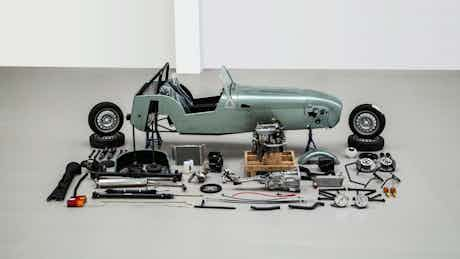What is a kit car?
February 08, 2023 by carwow staff

Want to get to grips with a kit car? Our guide contains everything you need
The vast, vast majority of modern cars are made in sophisticated factories with robots, countless computer systems and myriad monitoring checkpoints ensuring every nut, bolt, screw and wire is where it ought to be.
Kit cars, though, can be built by you, in your own garage, and at your own pace, using components supplied by a specialist manufacturer.
Here, we dig into the world of kit cars, detailing what you need to know if you’re considering taking the plunge.
What is a kit car?
Kit cars, as the name suggests, are cars that are supplied as a kit that you build at home. After you’ve paid for the kit, delivery of all the components you need to build a complete car will be arranged, leaving you to get building – though you will need some specialist tools (see below).
Different kits will be configured in different ways, requiring different amounts of assembly.
Caterham, one of the better-known suppliers of kits cars (they also offer factory-built cars), typically sells kits where the car’s body and chassis (the structure on which the body sits) are pre-assembled, leaving you to fit the engine, gearbox, wheel arches, axles, suspension, cooling system, and other components.
Factory Five, meanwhile, will sell you a kit for its Shelby Cobra Daytona replica, called the Type 65 (the firm has 11 other kits you can choose from), where the tubular chassis comes separate from the body panels. You will need to attach the body to the chassis in addition to fitting the engine, seats, suspension and so-on (although fitting the body panels actually comes quite late in the build process).

How do you build a kit car?
By following the instructions.
We jest, but this is probably the most important piece of advice, as while kit cars tend to be far simpler machines than even the average supermini, nuts, bolts and fixings must be tightened to the correct torque, while the assembly must take place in a specific order, and with the right greases, adhesives, silicones and threadlockers all being applied in the correct specifications, amounts and locations.
In most instances it would be more accurate to say that kit cars are assembled, rather than being built. The engine, for instance, will come as a complete unit, as will the gearbox, though you will often need to attach these two parts yourself, prior to installing them in the car.
Take a look at this assembly manual from Caterham to get a flavour of what’s involved.
Is building a kit car easy?
Define “easy”.
Compared to building a Lego set, kit cars are pretty tricky, though they work on comparable principles.
Most people who undertake building a kit car have a fair degree of mechanical or engineering knowledge, or enough passion to sustain their learning as they go, but it’s fair to say that having a relatively practical mindset will make building a kit car easier.
That said, kit-car instructions tend to be very detailed, while kit-car companies typically have helplines staffed by experts with technical knowledge of how to build the kits, should you encounter any difficulties during the assembly process.
We should highlight, though, that you should be prepared for the long haul if you invest in a kit car: it is not unknown for customers to find they don’t have as much time as they thought they would to devote to a build, leaving them with a half-built project they ultimately end up selling.
That’s not to say building a kit car isn’t enjoyable, though: those who undertake such a project tend to relish the challenge, while also having something that is very much ‘theirs’ at the end of it – but just make sure you’re fully committed to the idea, and speak to people on kit-car forums online, or the kit-car company, if you’re in any doubt before taking the plunge.
How long does it take to build a kit car?
How long it takes to build a kit car will depend on how often you can get around to working on it. Doing a couple of hours every weekend will see it potentially take over a year to complete a kit car, whereas if you can book a chunk of time off work and dedicate this time to building the car, you could get it done in a month.
It is also fair to say that some people will find some tasks harder than others. A job that should take one hour to complete may take six if you’re struggling, while there is also the possibility that you will install something incorrectly, having to undo and redo it, adding significant time to the build.
You may also find that some of the tools you have bought aren’t up to the job, potentially entailing delays as you purchase new ones.
And don’t underestimate how much having an extra pair of hands to help can speed up the process. A tricky job involving heavy or bulky components that might take one person four hours to complete could take two people two hours, as an example. In some instances a helper is required by the instructions, and essential for safe working.
Westfield cars has previously estimated it takes between 120 and 150 hours to build one of their kits into a car, to give you some idea.
Do I need any special tools to build a kit car?
Yes, you absolutely do. Different kits will have different requirements, but at the very least you will need an engine hoist (though these can be rented), a set of axle stands, plus numerous screwdrivers, Torx drivers, glues, greases, pliers, spanners, lubricants, knives and saws. You’ll also need a torque wrench (possibly two) so nuts and bolts can be done up to the correct tightness, while a rivet gun and other tools not found in the typical DIYer’s toolbox will be required. Some kit-car companies will sell you a dedicated toolkit to help you with the build. Draper has a kit dedicated to Caterham builds, complete with trolley jack and axle stands, as an example.
You’ll also need a covered, indoor space such as a garage to work in, plus an electricity supply, and don’t forget how cold such places can get in winter, so consider investing in some kind of appropriate space heater.
How much do kit cars cost?
Without wishing to state the obvious, it depends on the kit. Assembly kits from Caterham start at £29,990, saving you £2,595 on a factory build (as of Feb ‘23) – though that’s before you start adding extras like carbon-fibre dash inserts, a spare wheel etch.
A Factory Five Type 65 Coupe starts at £24,600, while DAX will sell you a chassis for £2,260, a DAX 01 body for £3,880, and various other modules (EG brake kits, electrical kits, suspension) individually, allowing you to both spread the costs out, and configure the car to your wishes.
Does a kit car need to be approved before it can be driven?
Yes, absolutely. First, it’s a good idea to get the car checked over by an expert once you have finished – Caterham offers just this service.
Second, before a kit car can be driven on the road, it must be put through Individual Vehicle Approval (IVA) by the Driver and Vehicle Standards Agency. You will need to apply for a vehicle identification number (VIN) before you can apply for an IVA. It can take 20 working days to get an IVA inspection appointment once you have completed the application process, and then transport (EG on a trailer) the car to a DVSA IVA centre, which are dotted around the country (there are three in the east of England, for example, but only one in Scotland, and one in Wales).
Some kit-car companies will inspect the car and put it through its IVA on your behalf once you have finished building it.
Once the car passes its IVA (it’s a strict, technical assessment, so not all do at the first attempt) it will be issued with a ‘Q’ number plate, and can be legally drive on the road, once you’ve sorted road tax and car insurance.
Change cars online with carwow
Not feeling the idea of a kit car? Looking for an easy way to change your car? Then carwow is the place to go. You can sell your car online for a great price, and get the best deals on a new one. All through our network of trusted dealers and all from the comfort of your home. Tap the button below to get started today.















